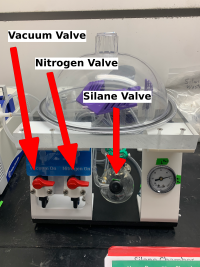Table of Contents
Vapor Silanization Rig Safe Operating Procedures New
9/16/23 Yanis Yankauskas yanis@ucsb.edu
Location
The vapor silanization rig is located in the first fume hood you see to your left when you walk in the door of the microfluidics lab, Elings 3430.
Safety
Trimethylchlorosilane is flammable, toxic, and reacts with water vapor. It can make you sick if inhaled and ignite if it reacts with air or water vapor. It may only be used in the vapor silanization rig inside of a fume hood. Do not let the pressure inside the chamber exceed 15 in Hg. The silane valve must always be opened in a nitrogen atmosphere. Protective eyewear, a lab coat, and gloves must be worn. Make sure the fume hood is closed when you are not working inside of it. Do not handle the silane without consulting the MSDS.
The new glass reservoir has about 14x the free liquid surface area as the previous reservoir. This means that the TMCS evaporates roughly 14x faster than before! It will reach atmospheric pressure and leak within 2 hours if the silane valve is left open. Therefore, we recommend that you only open the valve for the first 5 minutes of deposition. Then fully close the valve and resume your deposition for as long as you need.
Trimethylchlorosilane
Synonyms:
- TMCS
- Trimethylchlorosilane
- Trimethylsilyl chloride
Formula: C3H9ClSi Molecular weight: 108.64 g/mol CAS-No.: 75-77-4 EC-No.: 200-900-5
This protocol is intended for gas-phase monolayer deposition of a silane to serve as a counter-adhesion agent for glass or silicon substrates. The chemical trimethylchlorosilane will be referred to as silane for the purposes of this protocol. It can be deposited onto silicon and glass substrates and etch metal oxides (e.g. alumina).
Operating Guidelines
- Place your wafer inside the chamber. Check the O-ring seal. If dirty, wipe with a Kimwipe. Ensure that the O-ring is fully seated in the groove.
- Pull a vacuum by turning on the pump and then the red “Vacuum” valve. When the pressure reads about 15 inHg, turn the pump off and close the valve. Test the vacuum by waiting a minute or two and making sure the pressure reading stays steady.
- Turn on the N2 on the side of the fume hood. You only need to turn the knob once or twice.
- Open the Silane chamber N2 valve until the pressure reads about 5 inHg, then turn on the pump and open the vacuum valve until the pressure reads 15 in Hg. Repeat this cycle 5 times, make sure to turn off the pump once you are done.
- Flip the sign to “IN USE”.
- Close the fume hood and set a timer for 40 minutes.
- When your cycle is complete, update the logbook with your end time.
- Open the N2 valve until the pressure reads 5 in Hg. Open the vacuum valve until 15 in Hg. Repeat 5 times to purge the chamber again.
- Close the N2 valve on the side of the fume hood.
- Remove your wafer.
- Flip the sign back to “AVAILABLE” and close the hood.

